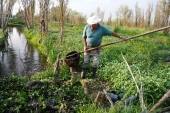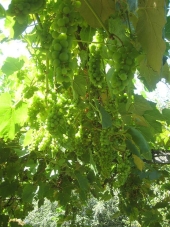posted 16 years ago
In a thread on asparagus, and as part of a larger effort to plan for a new property, Jennifer asked what crazy plan of mine seemed more feasable now that I know some grapes fruit in rich soil.
The basic idea is to have a maze of waist-high or taller garden beds, edged with woody species, tall enough that the paths between them form a network of chicken paddocks.
Early on, this would start by planting a careful pattern of shrubs, vines, and a few trees (especially along the north side), and building a garden wall in hugelkultur style with a framework of pallets, and filled with municipal wood chips and garden waste, all topped with soil from inside the perimeter. The area inside would be planted with grains and pulses where allowed by more permanent plants.
Once the earthen wall was complete (high and deep enough to contain the chickens and their noise), and enough feed was stored away, a chicken coop could be built inside. Pallets or wickets would be used to define several paddocks, usually between double rows of woody plants, leaving a "moat" that the chickens have perpetual access to just inside the outer wall.
As time went by and organic matter became available, hugelkultur walls would replace (or just bury, if that's easier...) the pallet/wicket barriers. In some places, wickets or other temporary barriers would remain appropriate, but the area available for intensive gardening would increase as paddock productivity increased. Ideally, garden wastes and pests could easily be thrown into the current paddock or into the moat from where they were picked up. Used mulch, chicken waste, and picked-over garden waste would naturally be a significant source of material for new bed construction, and some height would come from digging down into the soil under the paths/paddocks. The new beds would also presumably allow some of the woody plants to root from the side.
As the edges of the raised beds, pigeon peas are an obvious choice, and it's nice to know grapes might also be appropriate. With a fairly wide path, foliage from these can be mostly trained away from the surface of the raised beds. Some locations would need a shade-tolerant species like beaked chestnut.
I would want a lot of wood chips or twigs on the paths, and so purslane and white clover seem like good candidates for chicken forage. It might also make sense to build a little curb near the wall, in which to cultivate forage plants that don't stand up to traffic or break through mulch so well. As Paul has mentioned, plants can also be added up the sides.
I'm toying with the notion of super-productive biomass plants as part of the system, especially early on...maybe a 55 gallon barrel full of giant knotweed.
This idea has been bouncing around in my head for months, it's good to see it typed out.
"the qualities of these bacteria, like the heat of the sun, electricity, or the qualities of metals, are part of the storehouse of knowledge of all men. They are manifestations of the laws of nature, free to all men and reserved exclusively to none." SCOTUS, Funk Bros. Seed Co. v. Kale Inoculant Co.


















































